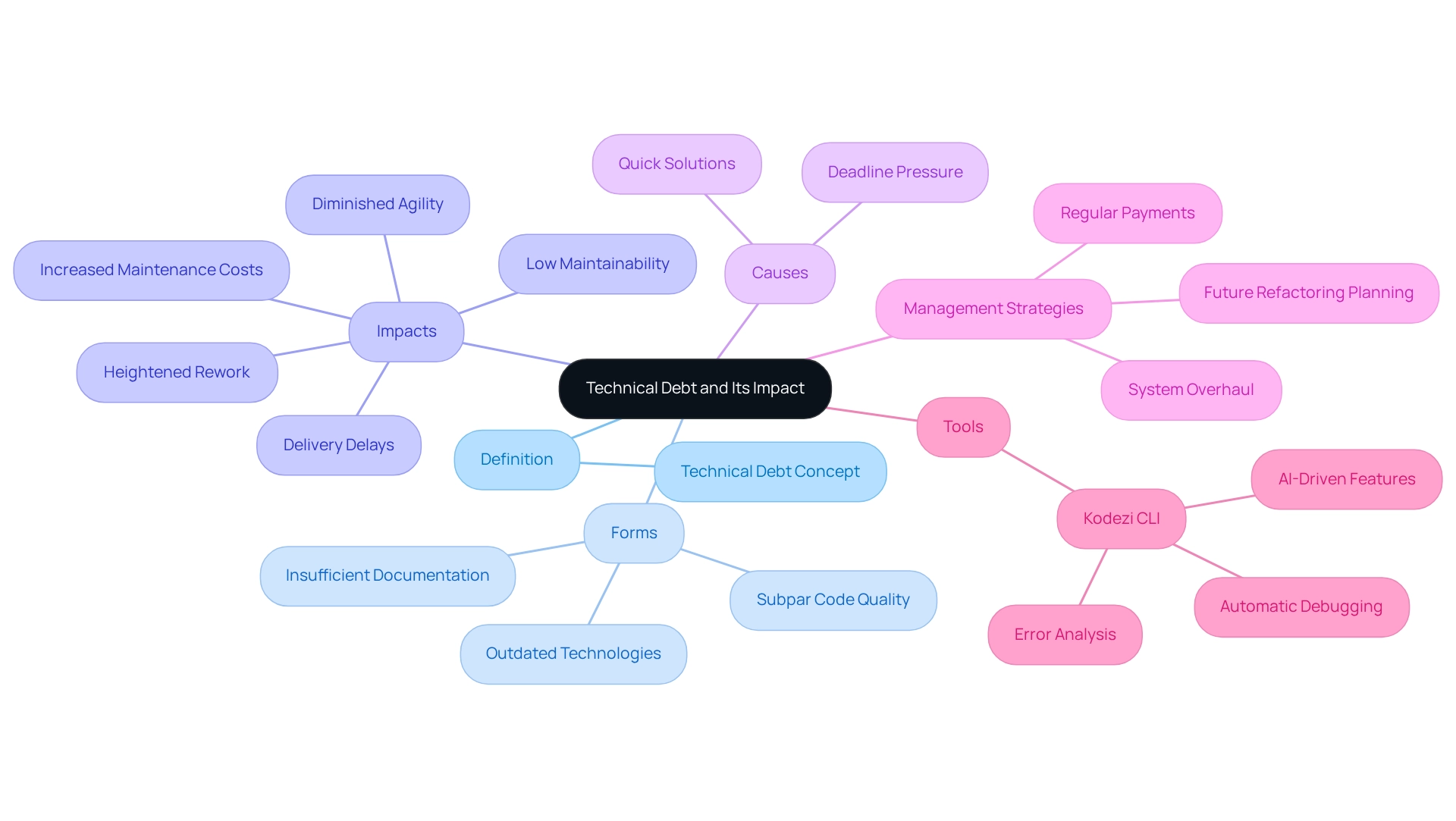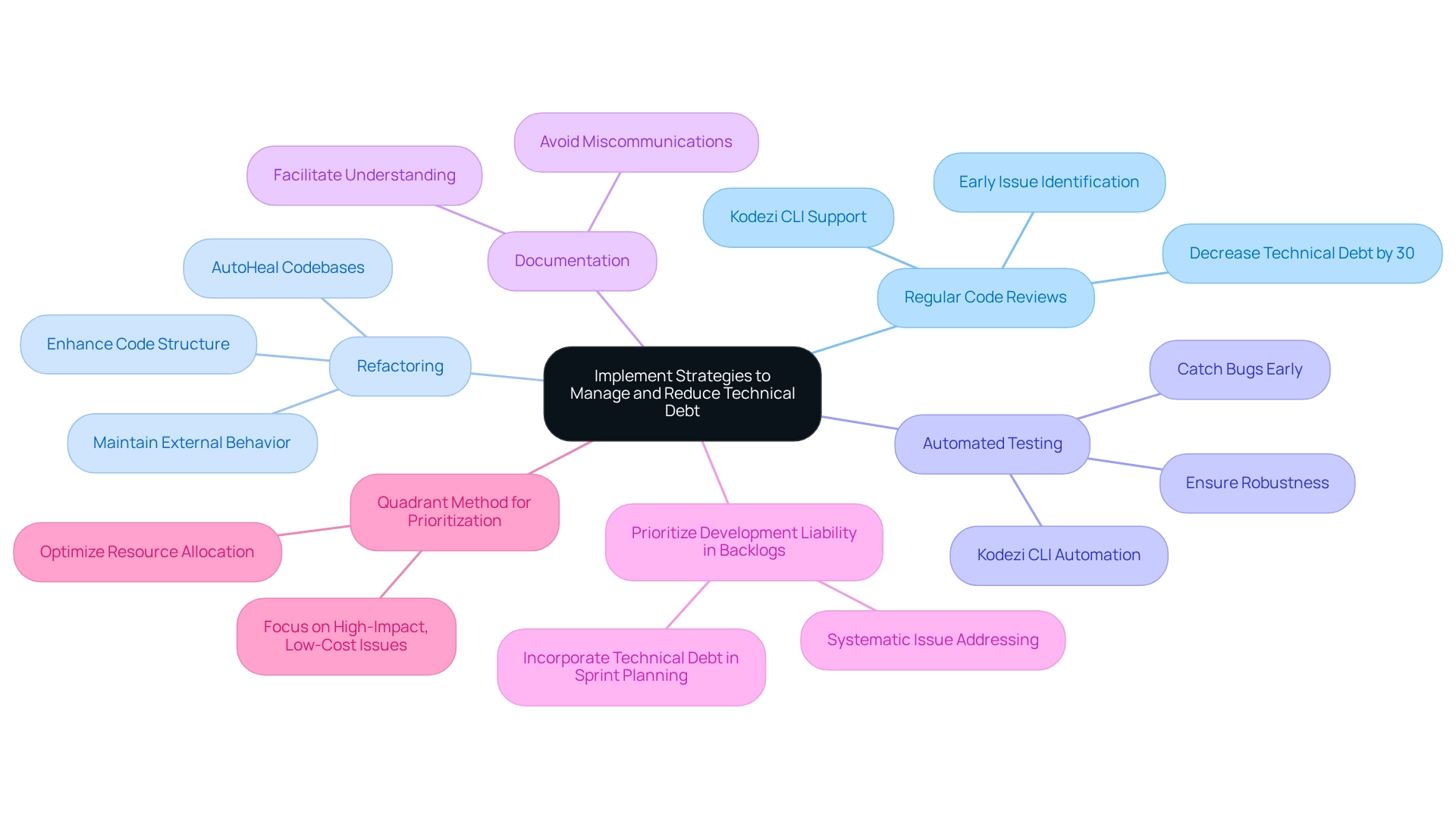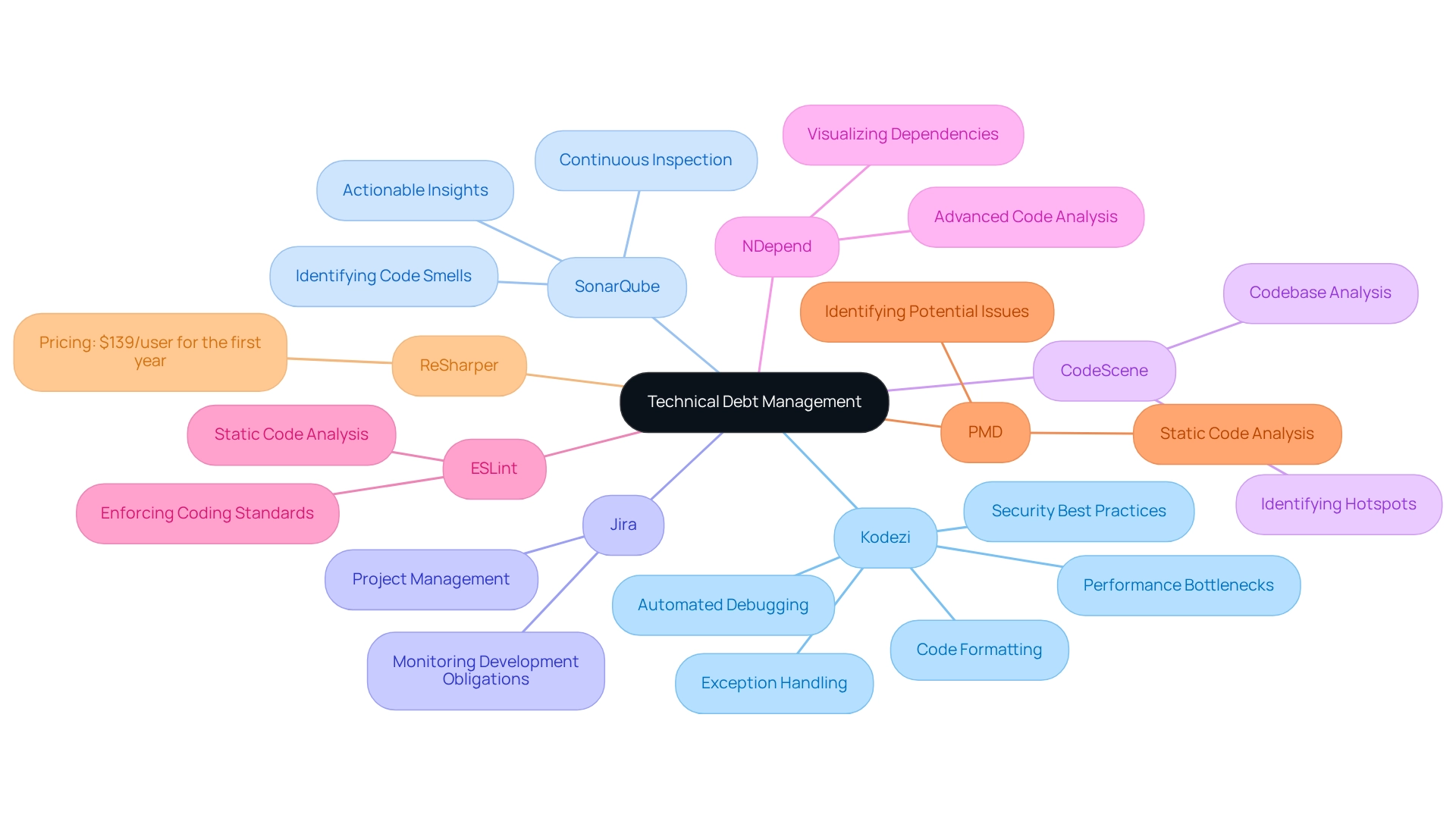Overview
In the realm of software development, managing technical debt is a significant challenge that developers frequently encounter. This article explores four essential strategies to tackle this issue:
- Regular code reviews
- Refactoring
- Automated testing
- Maintaining comprehensive documentation
These approaches are not merely suggestions; they are backed by evidence indicating that proactive management can significantly reduce technical debt. Furthermore, they enhance software quality and ensure project scalability, ultimately leading to more efficient development processes.
Have you ever wondered how to effectively manage technical debt in your projects? Kodezi offers solutions that directly address these challenges with specific features designed to streamline your workflow. By implementing these strategies, you can experience improved productivity and code quality, making your development efforts more efficient and effective.
In addition, utilizing Kodezi's tools can lead to substantial benefits, such as reduced bug rates and enhanced team collaboration. Why not explore the tools available on the platform? They could be the key to transforming your coding practices and achieving better results in your projects.
Introduction
In the ever-evolving landscape of software development, coding challenges are a common concern for teams striving to maintain code quality and project efficiency. One significant issue that has emerged is technical debt, a term that encapsulates the hidden costs associated with opting for quick fixes over sustainable solutions. This often leads to challenges such as increased maintenance expenses and decreased software performance.
As organizations grapple with the repercussions of technical debt, recognizing its signs becomes essential. Furthermore, implementing effective management strategies is crucial for mitigating its impact.
This article delves into the intricacies of technical debt, exploring its effects on software projects, identifying key indicators within codebases, and offering actionable strategies for mitigation. By leveraging advanced tools and fostering a culture of proactive management, development teams can not only alleviate the burdens of technical debt but also pave the way for sustained innovation and growth.
Define Technical Debt and Its Impact on Software Projects
Technical obligations represent the hidden costs of extra rework that arise when developers opt for quick solutions instead of more efficient, albeit time-consuming, methods. This issue can take various forms, such as subpar code quality, insufficient documentation, and reliance on outdated technologies. The impact of engineering liabilities on software projects is significant, often resulting in increased maintenance costs, diminished agility, and a decline in overall software quality. For example, projects encumbered by substantial technological liabilities frequently encounter delays in feature delivery, as developers spend more time resolving existing issues rather than implementing new functionalities.
Have you ever considered how deadline pressure contributes to these liabilities? Recent research indicates that this is the most commonly cited reason for the accumulation of software technical debt, leading to delivery delays, poor maintainability, and heightened rework. According to Robert Ramač, "The objective of this research is to collect representative empirical data about the TD concept, foremost about its prevalence within the IT industry alongside with the identification of TD causes and effects." Understanding and managing software technical debt is crucial for sustaining a robust codebase and ensuring the long-term success of software initiatives.
Enter Kodezi CLI, a versatile tool tailored for B2B engineering teams. It autonomously enhances software quality and resolves issues before they escalate to production. By leveraging Kodezi's AI-driven features, organizations can automate programming corrections and error analyses across various languages and IDEs, effectively mitigating the effects of technological liabilities. Kodezi stands out from competitors by prioritizing automatic debugging and code correction over mere code autofilling.
Furthermore, Kodezi offers both free and paid plans, making it accessible to a diverse range of users. As highlighted in various case studies, organizations that implement structured strategies for managing their software technical debt can better align their development efforts with broader organizational goals. Andrew Sharp emphasizes the importance of monitoring software technical debt to understand its business impact, underscoring the need for awareness in minimizing its repercussions. Additionally, statistics reveal that a significant portion of software projects are affected by software technical debt, underscoring the necessity for proactive management. So, what strategies are you employing to tackle these coding challenges?

Identify Signs of Technical Debt in Your Codebase
Identifying software technical debt in your codebase is crucial for effective management. Developers often face significant coding challenges, including issues that can hinder maintainability and lead to further complications. Here are common signs to watch for:
- Code Smells: Indicators such as overly complex code, duplicated segments, or lengthy methods often signal deeper issues that require attention. These programming issues can complicate maintenance efforts due to software technical debt. Frequent bugs in your software indicate that software technical debt may be building up, which affects the overall stability. Automated debugging can assist in identifying and resolving these issues promptly, offering detailed insights into what went wrong and how it was corrected.
- Slow Performance: Applications displaying lag or sluggish response times frequently indicate inefficiencies within the programming, which can arise from unresolved issues. Kodezi's automated debugging tools can effectively fix performance bottlenecks, ensuring your application runs smoothly and efficiently.
- Lack of Documentation: Insufficient documentation can create misunderstandings and complicate maintenance efforts, making it harder to manage the code effectively.
High maintenance costs can suggest that software technical debt is accumulating due to rising maintenance expenses. Regularly assessing these signs is essential to preemptively address potential challenges.
Statistics indicate that a minimal ratio of less than 5% is optimal for showcasing the benefits of proactively tackling these problems. This ratio emphasizes the significance of identifying the indicators of software technical debt early on. Furthermore, cooperation among specialized and non-specialized participants is essential for recognizing and prioritizing technology liabilities. As noted in the case study titled 'The Cost of Ignoring Software Technical Debt,' neglecting these signs of software technical debt can lead to increased maintenance costs and reduced code quality, ultimately jeopardizing project success. The saying, 'Technical obligations can sneak up on you,' acts as a warning for developers about the nuances of obligation accumulation. By staying vigilant and addressing these indicators, developers can ensure the long-term viability of their software projects.
Implement Strategies to Manage and Reduce Technical Debt
Overseeing and minimizing technological obligations necessitates a strategic method. Developers often face significant coding challenges that can impede productivity. How can these challenges be effectively addressed? Kodezi offers a suite of solutions designed to streamline the development process and enhance software quality.
- Regular Code Reviews: Implementing regular code reviews is crucial for the early identification of potential issues. Research indicates that efficient programming reviews can decrease software technical debt by as much as 30%, enabling teams to tackle issues before they develop into major obstacles. With Kodezi serving 22 prominent clients, the emphasis on efficiency and scalability is paramount in software development. Furthermore, Kodezi CLI enhances this process by autonomously improving software quality and resolving issues before they reach production. For a quick start, check out our 5-minute quickstart and see a demo to understand how it works.
- Refactoring: Regularly refactoring code enhances its structure without altering its external behavior. This incremental enhancement can significantly decrease software technical debt over time, which will make the codebase more maintainable and efficient. Kodezi CLI supports this by providing tools that help teams quickly AutoHeal codebases, streamlining the refactoring process.
- Automated Testing: The integration of automated testing is essential for catching bugs early and ensuring that new changes do not introduce additional software technical debt. This proactive approach not only enhances software quality but also streamlines the development process. Kodezi CLI can assist in automating these tests, ensuring that code remains robust and reliable.
- Documentation: Maintaining comprehensive documentation of the codebase is vital for facilitating understanding and maintenance. Clear documentation aids in avoiding the buildup of financial obligations caused by misunderstandings and miscommunications among group members.
- Prioritize Development Liability in Backlogs: Treating development liability as a primary focus in project management is crucial. By incorporating software technical debt in sprint planning and prioritizing it alongside new features, groups can ensure that engineering issues are systematically addressed, fostering a culture of ongoing enhancement.
- Quadrant Method for Prioritization: Employing the Quadrant Method enables teams to prioritize system issues based on cost-to-repair and potential impact. This method focuses on addressing high-impact, low-cost issues first, optimizing resource allocation and maximizing benefits.
- Strategic Planning for Financial Obligation Reduction: Organizations that align their strategies for financial obligations with broader business objectives can transform these challenges into opportunities for growth and innovation. As noted by NextGen's managers, "Having easy access to this metric enabled NextGen to reach its target of 10% and continue to monitor it, keeping it between their 10-20% sweet spot." By setting clear criteria and allocating resources to liability reduction, companies can effectively handle their technological obligations and promote business growth. The case study titled 'Strategic Planning for Reduction of Challenges' illustrates that by committing to ongoing efforts, organizations can transform challenges into opportunities for growth and innovation.

Utilize Tools and Resources for Effective Technical Debt Management
Effective management of technical debt is crucial for maintaining software quality and ensuring project scalability. Developers often face significant coding challenges, such as identifying bugs and enhancing code quality. How can these challenges be effectively addressed? Enter Kodezi, a professional OpenAPI specification generator that stands out in this domain.
Kodezi offers automated debugging, enabling developers to instantly identify and resolve issues within the codebase. With detailed explanations and insights into what went wrong and how it was resolved, Kodezi significantly enhances programming quality. It addresses performance bottlenecks, uncovers security issues, adds exception handling, and improves formatting—all within seconds. Furthermore, Kodezi enforces security best practices and programming standards, ensuring compliance with the latest guidelines. This makes it an essential resource for teams focused on efficiency, particularly in managing software technical debt, alongside Kodezi and several other tools that can further assist development groups.
SonarQube is well-known for its continuous inspection capabilities, identifying code smells, bugs, and vulnerabilities while providing actionable insights for quality improvement. Jira serves as an indispensable project management tool, allowing teams to monitor development obligations alongside regular tasks. By prioritizing code-related issues, teams can ensure they are addressed promptly, integrating them seamlessly into their overall workflow.
Similarly, CodeScene analyzes codebases to pinpoint hotspots and potential problem areas, offering insights that help teams focus their refactoring efforts effectively. NDepend provides advanced code analysis features, enabling teams to visualize dependencies and measure various code quality metrics, facilitating informed decision-making regarding code issue management. Static code analysis tools like ESLint and PMD play a vital role in enforcing coding standards and identifying potential issues early, preventing them from escalating into significant problems.
Utilizing these tools allows development groups to gain better visibility into their code issues, fostering a proactive approach to management. For instance, a case study titled 'Ensuring Scalability in Development' highlights that codebases with minimal technical debt adapt more easily to changes and incorporate new technologies effectively. This adaptability is essential for organizations aiming for innovation and growth. As Amartya Jha aptly states, 'This isn’t just another tool—it’s your shortcut to a cleaner, more efficient codebase.'
Moreover, considering the financial aspect, tools such as ReSharper start at $139 per user for the initial year, a significant factor for teams assessing their options. By integrating these tools into their workflows, including options like Perforce, which offers tailored pricing for large enterprises, teams can enhance their coding practices and maintain high standards in software development.

Conclusion
Technical debt presents a significant challenge for software development teams, impacting code quality, project efficiency, and overall success. How does your team address the coding challenges that arise from technical debt? By understanding its implications, recognizing the signs of its accumulation, and implementing effective management strategies, organizations can mitigate its adverse effects. Key indicators such as code smells, frequent bugs, slow performance, and high maintenance costs serve as warning signs that demand attention to prevent further complications.
Employing structured strategies like regular code reviews, refactoring, automated testing, and maintaining comprehensive documentation can greatly reduce technical debt. Furthermore, prioritizing technical debt in project backlogs ensures that it is systematically addressed alongside new features, fostering a culture of continuous improvement. Leveraging advanced tools such as Kodezi, SonarQube, and Jira empowers teams to gain visibility into their codebases, enabling proactive management that supports long-term sustainability.
Ultimately, effectively managing technical debt transforms it from a burden into an opportunity for growth and innovation. By integrating these practices and tools into their workflows, development teams can enhance code quality, reduce costs, and drive successful outcomes. The time for organizations to prioritize technical debt management is now, as it is crucial for sustaining a competitive edge in the dynamic landscape of software development.
Frequently Asked Questions
What are technical obligations in software development?
Technical obligations refer to the hidden costs of extra rework that arise when developers choose quick solutions instead of more efficient, albeit more time-consuming, methods. This can manifest as subpar code quality, insufficient documentation, and reliance on outdated technologies.
How do engineering liabilities impact software projects?
Engineering liabilities can lead to significant issues such as increased maintenance costs, reduced agility, and a decline in overall software quality. Projects burdened with technological liabilities often face delays in feature delivery, as developers spend more time fixing existing problems rather than implementing new features.
What role does deadline pressure play in accumulating technical debt?
Deadline pressure is a major contributor to the accumulation of software technical debt, often resulting in delivery delays, poor maintainability, and increased rework.
What is the purpose of Robert Ramač's research on technical debt?
The objective of Robert Ramač's research is to gather empirical data about the prevalence of technical debt in the IT industry and to identify its causes and effects.
How can organizations manage software technical debt effectively?
Managing software technical debt is crucial for maintaining a robust codebase and ensuring the long-term success of software projects. Organizations that implement structured strategies for managing their technical debt can better align their development efforts with broader organizational goals.
What is Kodezi CLI and how does it help with technical debt?
Kodezi CLI is a versatile tool designed for B2B engineering teams that autonomously enhances software quality and resolves issues before they escalate to production. It uses AI-driven features to automate programming corrections and error analyses, helping to mitigate technological liabilities.
What distinguishes Kodezi from its competitors?
Kodezi stands out from competitors by focusing on automatic debugging and code correction rather than just code autofilling.
Are there different pricing options available for Kodezi?
Yes, Kodezi offers both free and paid plans, making it accessible to a wide range of users.
Why is it important to monitor software technical debt?
Monitoring software technical debt is important to understand its business impact and to minimize its negative repercussions, as a significant portion of software projects are affected by it.




